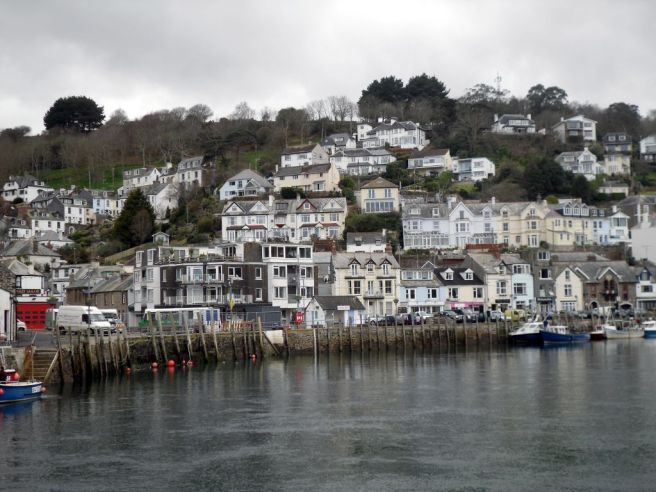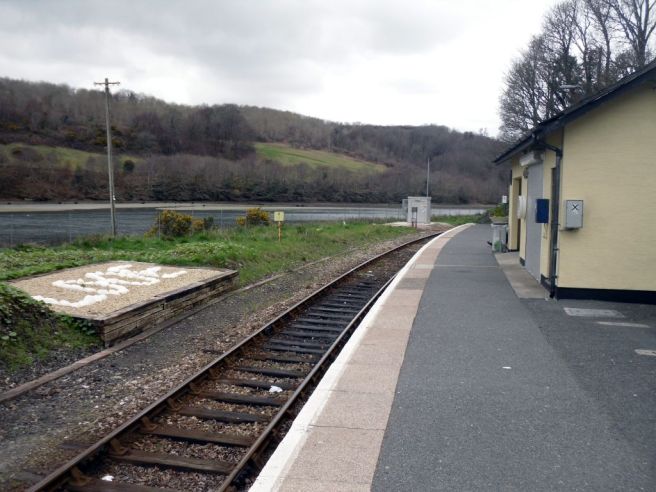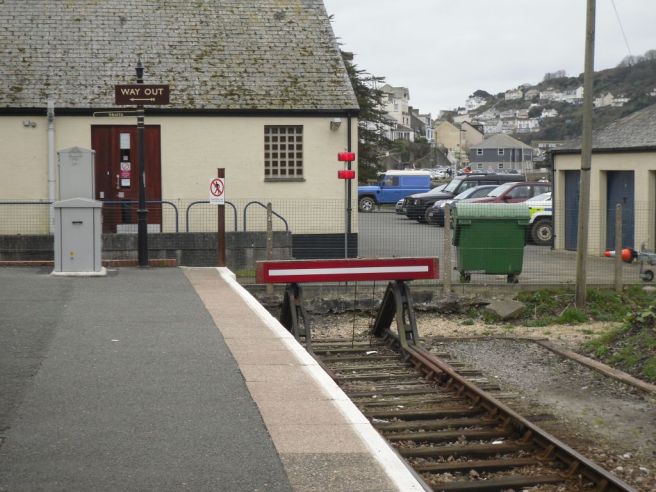 I decided not to wait for the next train at Sandplace, instead setting off for Looe via the most obvious and direct walking route – the A387 road. This decision turned out to be a slightly life-endangering one, for the road has no safe haven for pedestrians – no pavement, and not even a grass verge for parts of its length. I was forced to walk on the road itself – remembering, of course, the Highway Code’s stern warning to keep on the right so I face oncoming traffic.
I decided not to wait for the next train at Sandplace, instead setting off for Looe via the most obvious and direct walking route – the A387 road. This decision turned out to be a slightly life-endangering one, for the road has no safe haven for pedestrians – no pavement, and not even a grass verge for parts of its length. I was forced to walk on the road itself – remembering, of course, the Highway Code’s stern warning to keep on the right so I face oncoming traffic.
The road is quite narrow and features a few blind bends, which didn’t seem to trouble the numerous buses, lorries and the occasional tractor, who zoomed past as quickly as possible. At one point, I saw a police car approach, and I’m pretty sure it slowed down to let the officers inside get a good look at me. Perhaps they had received a report of a lunatic on the road (not altogether inaccurate).
 The railway line runs parallel to the road, but at a lower level, and it is largely hidden by trees, greenery, and (according to signs at the roadside) Japanese Knotweed.
The railway line runs parallel to the road, but at a lower level, and it is largely hidden by trees, greenery, and (according to signs at the roadside) Japanese Knotweed.
I saw a sign declaring Welcome to Looe, and thought my ordeal was at an end, but no – there was another good mile or so of trudging before I finally reached the actual edge of town and the relative safety of an actual, clearly delineated pedestrian walkway.
Roads and walking are bad, kids. Stick to the train.
I was cheered up by a sighting of That Lettering Style Which Seemed To Be Everywhere From The 1950s To The 1970s.
Looe is a small coastal town and fishing port. Here, the East Looe River (the course of which is followed by the railway from Coombe Junction) converges with the West Looe River before flowing into the English Channel. The river divides the town in two, with just a single bridge linking the two sides. I like to think there’s a snobbery along the lines of the North London/South London divide, but that’s probably wishful thinking on my part.
Although the fishing industry still plays its part, Looe is very much a tourist town and the harbour reflects this, with a mix of fishing boats and pleasure craft. In summer this must be a very pleasant place to spend a day. I was very wary of “vicious” seagulls – there’s a gang of five of them terrorising Looe, shown in the picture below. If you see them, contact police immediately… but don’t have nightmares. I hope they get an ASBO, or something.
I walked down the narrow streets, occasionally stopping to dodge a delivery van which squeezed through seemingly impossible gaps. Even in mid-March, Looe town centre was busy with shoppers, and everywhere was doing a roaring trade. The exception was one pub, which seemed to have a bit of a beef with Rupert Murdoch – join the club, mate.
Yeah, nice one Sky.
I spent an hour or so wandering the town, during which my only contributions to the town’s economy (sorry, Looe tourist board) were a souvenir mug from a gift shop and some lunch (a Cornish Pasty OF COURSE). I then made my way back to Looe station.
After the previous stops on the branch, Looe was a bit perfunctory – just a car park and a small hut on the platform, which was shuttered up (a shop and information centre operates from the building during the summer months). One thing it does have though: a proper totem! Finally I could get the “pole sticking out of head” shot that my adoring public demand.
The station is right on the edge of town. Wikipedia informs me that it used to be slightly closer to the town centre, but the original platform was demolished and the line cut back to its present end point. This happened in the 1960s, a time when the nation’s railway network seemed to be regarded as an inconvenience to be kept out of the way. These days attitudes are different, and local communities like to celebrate their stations; hence the recent 1950s branch line makeover and, at Looe, a plaque commemorating the line’s engineer.
For the first time that day, there were other people waiting at the station for the train. Rain started to fall again, so I and most of my fellow passengers opted for the relative dryness of the small platform shelter.
I heard the train long before we saw it; the driver has to sound the horn on approach to various minor level crossings. Eventually the diesel unit came into view and rolled to a halt. We climbed aboard quickly – the trains do not hang around at this terminus, departing as soon as the crew have changed ends.
I was glad to have a full 25 minutes or so to sit down and relax on the train. I had done a lot of walking and was feeling exhausted. And my travels were still not over for the day.














I absolutely hate that 1960s font. I find it incredibly depressing. If I see it somewhere, all I can think is, “you haven’t updated your signage in FIFTY YEARS”.
I remember fishing for crabs on Looe harbour when I was young. Think this line is an excuse to go back!
Hope I brought back some memories for you. I definitely recommend a trip on the line if you haven’t been on it (and if you have, I recommend doing it again!)
Actually, what is it with British seaside resorts and awful names? Looe, Skegness, Blackpool, Morecambe – they all sound miserable and grim. No wonder the British tourist industry is down the dumper.
Ach. Looe. A few years back I idiotically ran into the sea with my wallet in my swimming shorts pocket. Goodbye wallet.